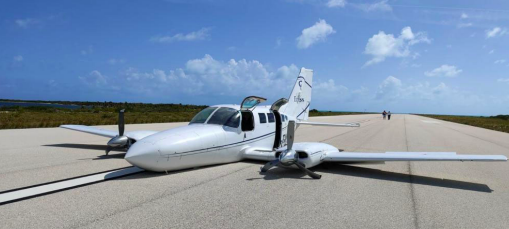Passenger Flight to Turks and Caicos Lands Wheels Up (Bad day)

Flight in Turks and Caicos hit the ground with the landing gear up — and the Normal Procedures checklist was unused during the flight.
In this AAIB (Air Accidents Investigation Branch) report, an aircraft headed to a Turks and Caicos destination landed without its landing gear being extended. The landing gear warning horn was found to be unserviceable after the accident. However, while it could not be determined when it failed, it was not tested prior to the flight, as prescribed in the operators’ Normal Procedures checklist. In addition, the Normal Procedures checklist was not used during the flight. Had it been, the pilot may have noticed the landing gear was not down, despite the warning horn not being serviceable.
The pilot and five passengers were on a scheduled flight from Providenciales International Airport, Turks and Caicos Islands to Harold Charles International Airport, Ambergris Cay, Turks and Caicos Islands.
This was the pilot’s seventh flight of the day.
The pilot reported that after he and the passengers had boarded their assigned aircraft, its engines were “reluctant to start.” As another Cessna 402C (C402C) was available, the pilot elected to change aircraft. The replacement aircraft had previously flown two sectors that day with another pilot.
After the pilot and passengers had changed aircraft, one of the passengers sat in the co-pilot’s seat, after the pilot had offered it to him. The pilot reported that he did a visual check of the outside of the replacement aircraft but did not do a thorough internal pre-flight check. This meant that the landing gear warning horn1 was not tested. The subsequent departure and cruise were uneventful. Runway 07 was in use at Harold Charles International Airport, the weather was good, and the wind was from 070° at 13 kt.
At about 3 nm to land, the pilot selected flaps 45 and stated subsequently that he believed he selected the landing gear down and saw three green lights, to indicate that the landing gear was down and locked. The approach continued without event until at the point of landing, when he felt that the landing gear touched down “gently.” However, the aircraft then began to skid on its underside and the propellers made contact with the runway. The aircraft slid down the runway before coming to a stop (Figure 1).
The pilot advised ATC of the situation and the airport’s RFFS were quick in attendance. Four passengers and the pilot exited through the pilot’s/front left side window, while one exited through the window of the main cabin door. There were no injuries.
The aircraft sustained extensive damage to its flaps, propellers and underside, and both engines were shock-loaded.
Analysis
The pilot commented that he usually tests the landing gear warning horn on every flight but did not do so on the accident flight. After the accident it was discovered that the landing gear warning horn was unserviceable. While it could not be determined when it failed, had it been found to be unserviceable by conducting a pre-departure annunciator test, the pilot would have had an opportunity to seek engineering assistance, and possibly get it rectified, prior to departure. With the warning horn not working, there was no alarm available to the pilot on the approach when flaps 45 were selected to indicate that the landing gear was not down and locked. Had he heard the horn, he would have probably either lowered the landing gear while on the approach or initiated a go-around before making another approach with it selected down.
The pilot said that he probably did not use the Normal Procedures checklist on the accident flight, and this was noticed by the passenger in the co-pilot’s seat. Checklists are there to assist pilots from forgetting to do essential actions during each phase of flight that, if not completed, could have had an adverse effect on the safety of the aircraft. It was likely that he was distracted and/or rushing due to the aircraft change, and this led to him not doing a thorough internal pre-flight check.
There were conflicting accounts between the pilot and some of the passengers as to whether a safety briefing had been given, or whether a safety card was shown. Had there been no safety briefing given to the passengers, they would have been ill equipped to deal with any evacuation. Had the pilot been incapacitated this could have led to unexpected delays to the evacuation that may have led to serious injuries had there been a fire, or the damage been more severe.
The pilot believed he lowered the landing gear prior to landing but did not use the checklist to confirm this. One passenger stated he did not feel or hear the sounds associated with the lowering of the landing gear, which he experienced on his next flight. While the landing gear handle was discovered in the down position it was more likely it was moved after the accident. However, it could not be determined when or by whom.
Read the passenger and pilot comments in the full AAIB report.
Content and image source: AAIB, “AAIB investigation to Cessna 402C, Businessliner, VQ-TIN,” May 12, 2022.
Become trained in troubleshooting and identifying root causes of issues and incidents.
REGISTER TODAY for a TapRooT® course and gain advantage, experience, and expertise from our professional instructors. Here are listings for our upcoming 2-Day and 5-Day courses:
2-DAY TAPROOT® ROOT CAUSE ANALYSIS TRAINING
5-DAY TAPROOT® ADVANCED ROOT CAUSE ANALYSIS TEAM LEADER TRAINING
We are global to meet your needs. If you need other times or locations, please see our full selection of COURSES.
If you would like for us to teach a course at your workplace, please REACH OUT HERE to discuss what we can do for you, or call us at 865.539.2139.



